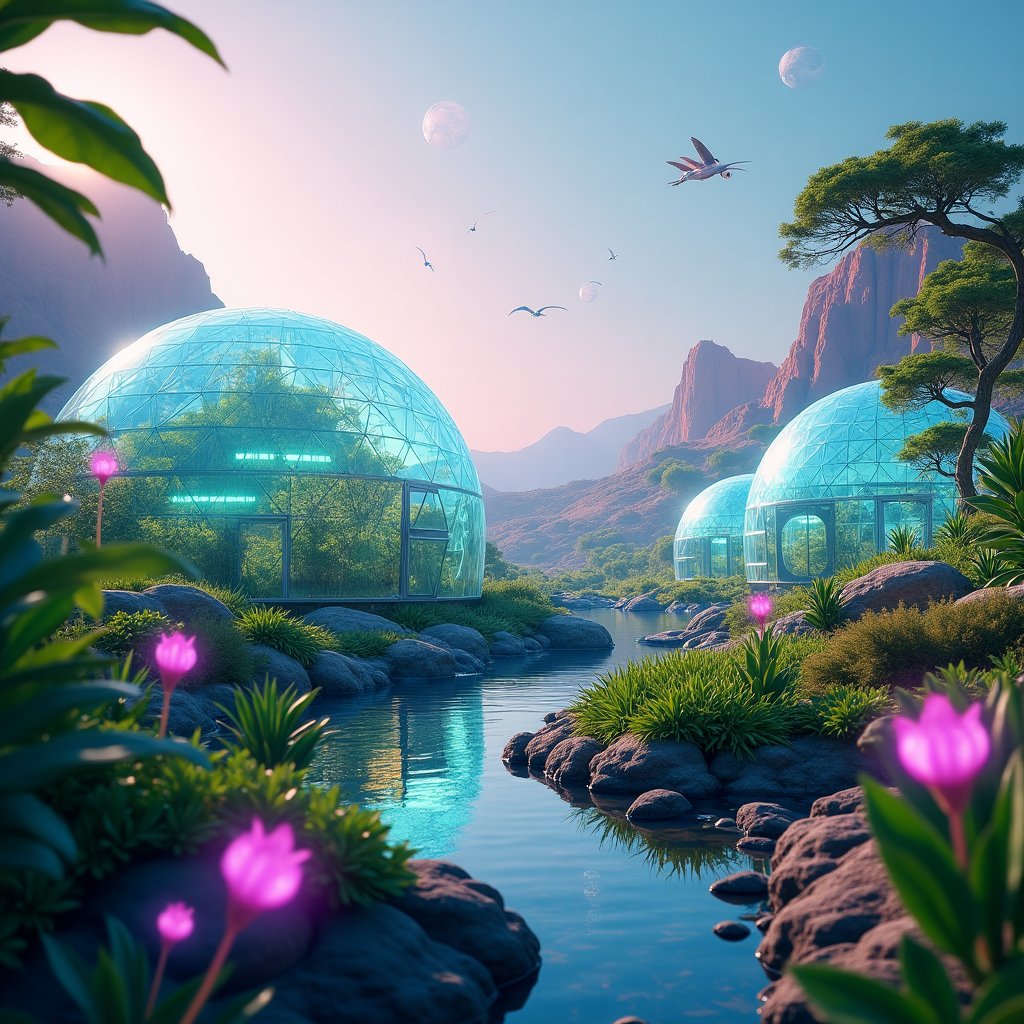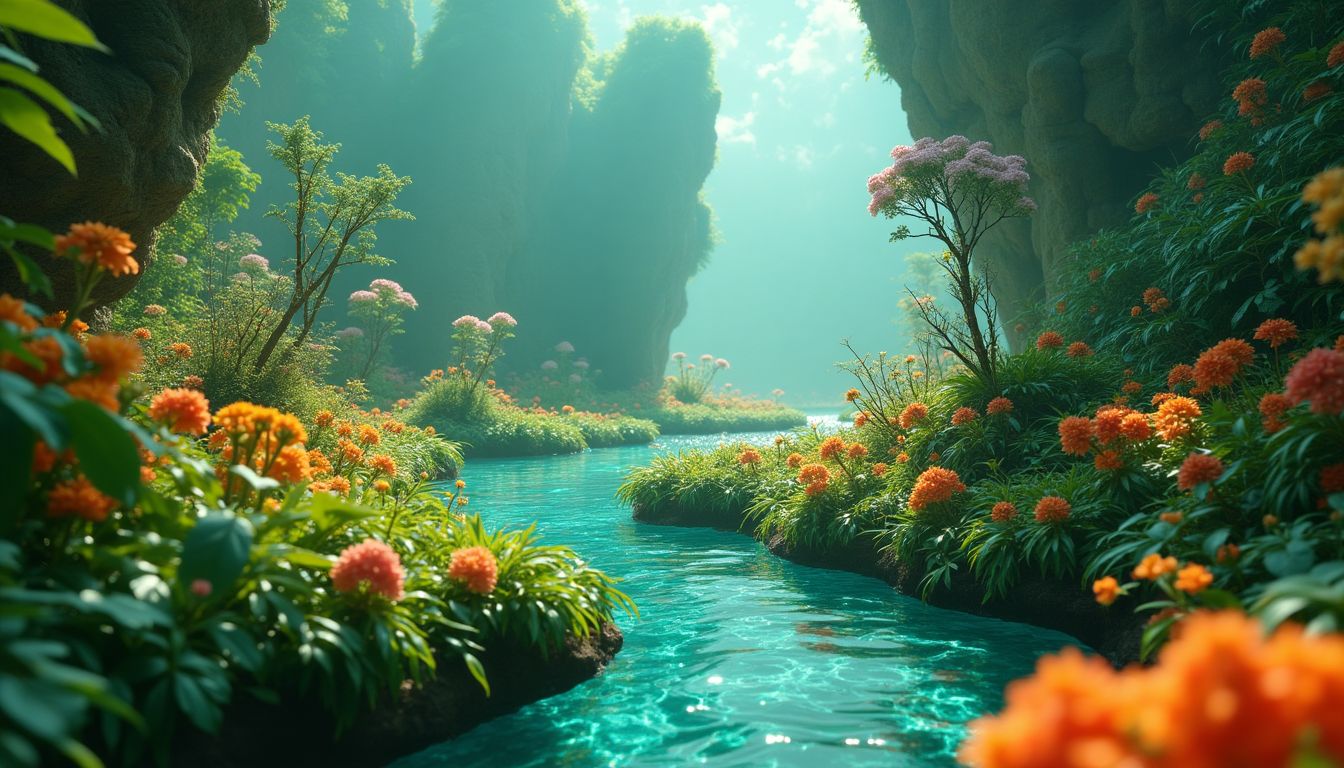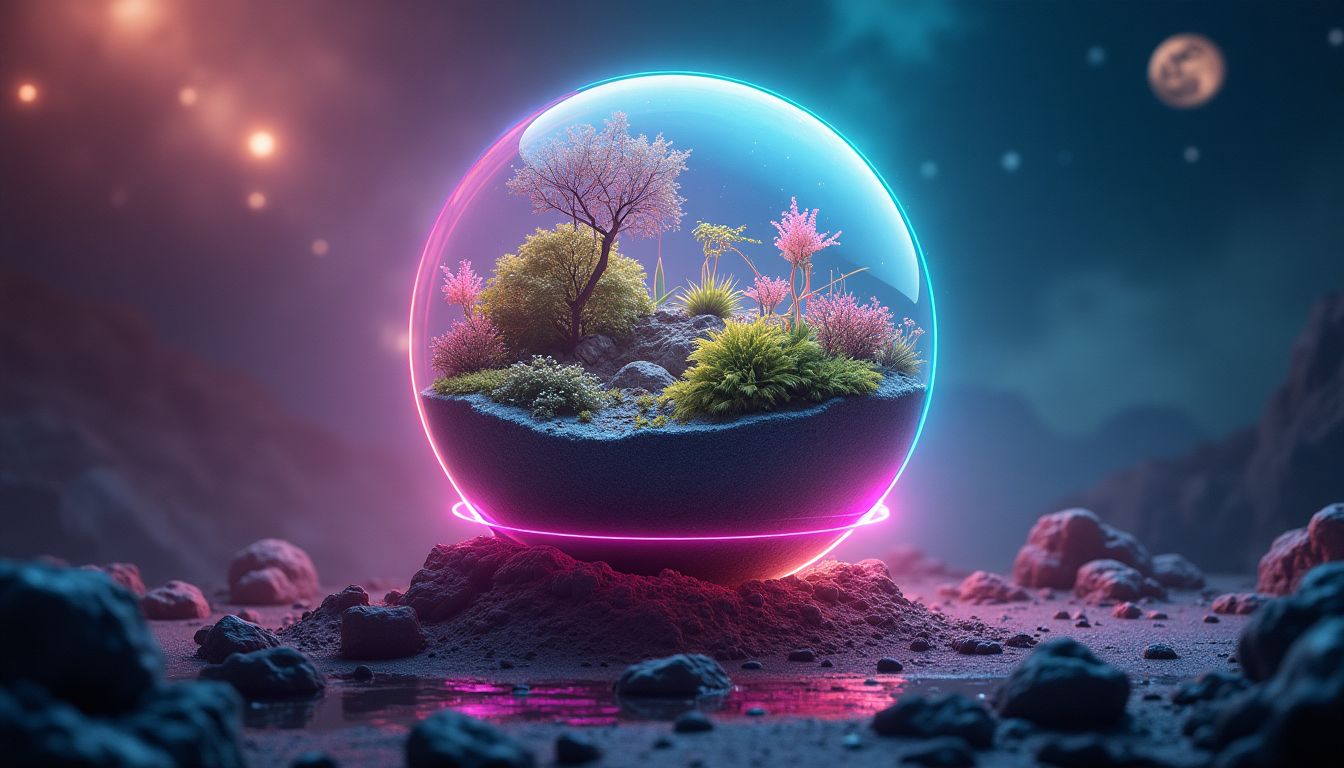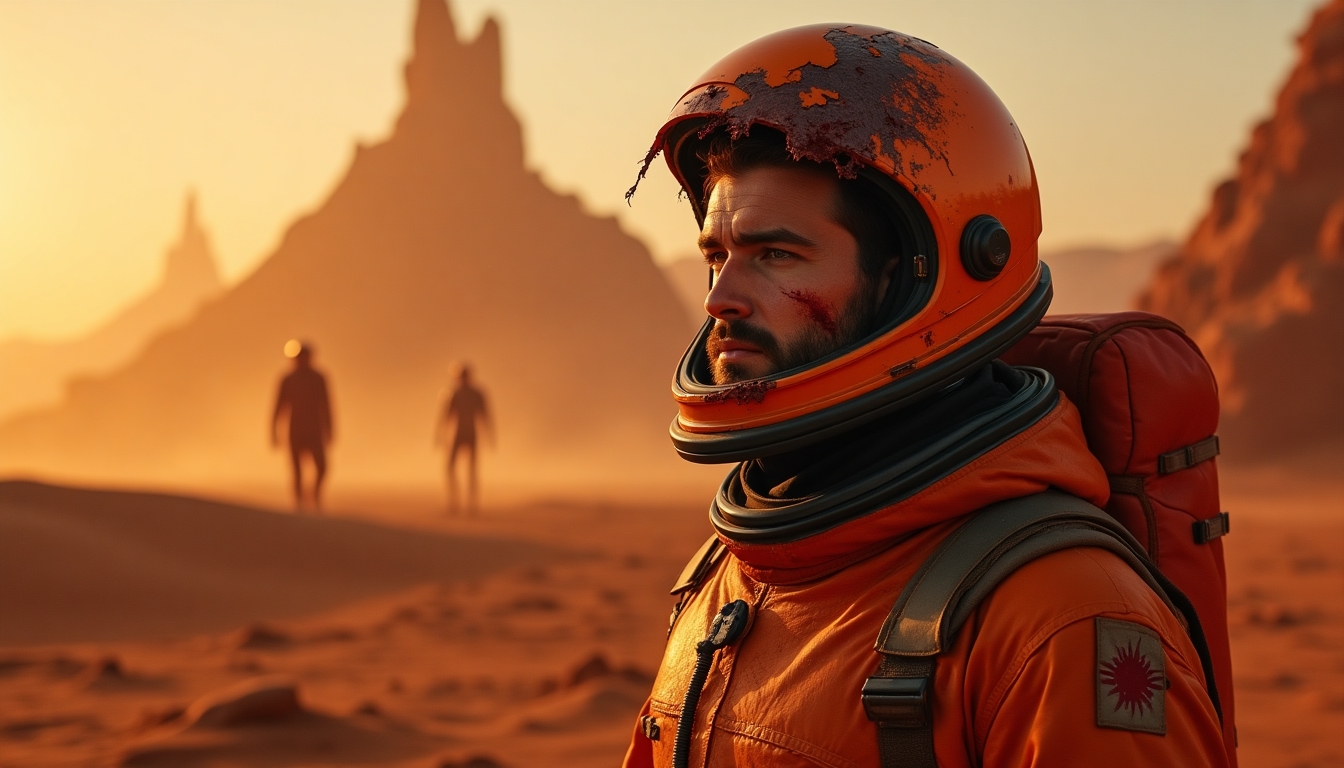Bioengineered Ecosystems for Space Habitats: Can AI Create Life Beyond Earth?
What if the key to colonizing Mars isn’t just rockets and robots, but a garden? A garden designed not by human hands, but by artificial intelligence. As we dream of planting flags on distant worlds, the real challenge isn’t just getting there—it’s staying alive once we arrive. The barren landscapes of Mars, the vacuum of space, and the icy moons of Jupiter don’t exactly roll out the welcome mat for Earth’s fragile biology. But what if we could engineer ecosystems that thrive in these hostile environments? And what if AI could be the mastermind behind it all?
This isn’t science fiction. Visionaries like Elon Musk, founder of SpaceX, have long championed the idea of making humanity a multi-planetary species. Meanwhile, researchers like Lynn Margulis, who revolutionized our understanding of symbiosis in ecosystems, have laid the groundwork for how life can adapt and thrive in extreme conditions. And let’s not forget Ray Kurzweil, the futurist who predicts that AI will soon surpass human intelligence, potentially solving problems we can’t even comprehend yet. Together, their ideas form the backbone of a bold new vision: bioengineered ecosystems for space habitats, designed and managed by AI.
But how do we get from here to there? How do we take the lessons of Earth’s ecosystems and apply them to the cold, airless void of space? And can AI really be trusted to design something as complex as a self-sustaining ecosystem? Let’s dig in.
1. The Challenge of Building Ecosystems in Space
1.1 Hostile Environmental Conditions
Space is not a friendly place. On Mars, temperatures can plummet to -80°F (-62°C) at night, and the thin atmosphere offers little protection from the Sun’s deadly radiation. The Moon? Even worse. No atmosphere, no water, and temperatures that swing from boiling to freezing in a single day. And don’t even get me started on the vacuum of space itself—zero pressure, zero oxygen, and a whole lot of nothingness.
These conditions make it nearly impossible for Earth’s ecosystems to survive without serious help. Plants can’t grow in Martian soil without nutrients. Microbes can’t recycle waste without water. And humans? Well, we’re pretty much useless without oxygen, food, and a cozy 72°F (22°C) environment. The challenge is clear: we need to create ecosystems that can withstand these extremes, and we need to do it with limited resources.
1.2 The Complexity of Self-Sustaining Systems
On Earth, ecosystems are self-regulating marvels. Plants produce oxygen, animals produce carbon dioxide, and microbes recycle waste into nutrients. It’s a delicate balance, one that’s taken billions of years to perfect. But in space, we don’t have billions of years. We need to recreate this balance in a fraction of the time, and we need to do it in a way that’s resilient to failure.
Imagine trying to build a house of cards in a hurricane. That’s what creating a self-sustaining ecosystem in space feels like. One wrong move—a failed oxygen cycle, a contaminated water supply—and the whole system collapses. And unlike Earth, there’s no backup plan. No forests to replenish oxygen, no oceans to purify water. Just a fragile bubble of life, floating in the void.
1.3 Lessons from Earth’s Ecosystems
So, where do we start? By looking at Earth’s most extreme environments. Take Biosphere 2, for example. This massive, sealed ecosystem in Arizona was designed to mimic Earth’s biosphere, complete with rainforests, oceans, and deserts. While it didn’t go perfectly—oxygen levels dropped, crops failed, and the crew nearly starved—it taught us valuable lessons about the challenges of closed-loop systems.
Then there are extremophiles, the tough little organisms that thrive in Earth’s harshest environments. From the boiling hot springs of Yellowstone to the frozen deserts of Antarctica, these microbes have evolved to survive conditions that would kill most lifeforms. By studying them, we can learn how to engineer organisms that can withstand the rigors of space.
But even with these lessons, the challenge remains daunting. How do we take these insights and apply them to the alien landscapes of Mars or the Moon? And how do we ensure that these ecosystems can adapt and evolve over time? That’s where AI comes in.
2. The Role of Bioengineering in Space Habitats
When it comes to building ecosystems in space, bioengineering is like the Swiss Army knife of science—it’s versatile, innovative, and occasionally a little intimidating. But how exactly can bioengineering help us create life-supporting systems in the vacuum of space? Let’s break it down.
2.1 Genetically Modified Organisms (GMOs)
Imagine a potato that can survive on Mars. No, this isn’t the plot of a sci-fi movie—it’s the future of bioengineering. By tweaking the DNA of plants and microbes, scientists can create organisms that thrive in extreme conditions. For example, researchers at NASA are experimenting with genetically modified plants that can withstand high levels of radiation, a major hurdle for life on Mars. These super-plants could provide food, oxygen, and even psychological comfort for astronauts far from home.
But it’s not just about plants. Microbes, the unsung heroes of Earth’s ecosystems, are also getting a genetic makeover. Scientists are engineering bacteria that can break down waste and recycle it into usable nutrients. Think of them as tiny, microscopic janitors keeping space habitats clean and functional. Who knew bacteria could be so… responsible?
2.2 Synthetic Biology
Synthetic biology takes bioengineering to the next level. Instead of just tweaking existing organisms, scientists are designing entirely new ones from scratch. Picture this: photosynthetic bacteria that produce oxygen, or algae that can purify water while doubling as a snack. These custom-made organisms could be the backbone of space ecosystems, performing specific tasks to keep the system running smoothly.
One exciting project in this field is the SpaceX-backed initiative to develop synthetic organisms for Mars colonization. By combining synthetic biology with AI, researchers hope to create a self-sustaining ecosystem that can adapt to the Red Planet’s harsh conditions. It’s like building a Lego set, but instead of plastic bricks, you’re using DNA.
2.3 Soil and Water Bioengineering
Let’s face it: Martian soil isn’t exactly fertile. It’s dry, dusty, and packed with toxic chemicals like perchlorates. But bioengineers are working on solutions to turn this barren dirt into a thriving garden. One approach involves simulating Martian soil in labs and testing which plants can grow in it. Researchers at Wageningen University have already grown radishes, peas, and tomatoes in Mars-like soil. Sure, they’re not exactly gourmet yet, but it’s a start.
Water is another challenge. On Mars, liquid water is scarce, so bioengineers are designing systems to recycle every drop. Biofilms—thin layers of microorganisms—can purify water by breaking down contaminants. These biofilms could be integrated into space habitats, ensuring a steady supply of clean water for drinking, farming, and even brewing space coffee (because let’s be honest, astronauts need their caffeine fix).
3. AI’s Role in Designing Ecosystems
If bioengineering is the Swiss Army knife, then AI is the brain behind the operation. Artificial intelligence has the potential to revolutionize how we design, manage, and optimize ecosystems in space. But how exactly does AI fit into this cosmic puzzle? Let’s dive in.
3.1 Simulating Ecosystem Dynamics
Creating an ecosystem is like conducting a symphony—every element has to work in harmony. AI can simulate these complex interactions, predicting how changes in one part of the system will affect the whole. For example, if you add more plants to produce oxygen, how will that impact the carbon dioxide levels? AI can run thousands of simulations to find the perfect balance.
One groundbreaking project is IBM’s AI-powered ecosystem simulator, which models energy and nutrient flows in real-time. This tool could be invaluable for designing ecosystems on Mars or the Moon, where every resource is precious. It’s like having a crystal ball, but for ecology.
3.2 Optimizing Resource Use
In space, resources are limited, and waste is not an option. AI can optimize the use of water, oxygen, and nutrients, ensuring that nothing goes to waste. Machine learning algorithms can analyze data from sensors to predict future needs and adjust the system accordingly. For instance, if the AI detects a drop in oxygen levels, it can increase the number of photosynthetic organisms to compensate.
This kind of optimization is already being tested in prototype habitats on Earth. The NASA-funded HI-SEAS project in Hawaii uses AI to manage resources in a simulated Mars habitat. The results are promising, showing that AI can keep systems running smoothly even in challenging conditions. It’s like having a personal assistant for your ecosystem—except this one never takes a coffee break.
3.3 Adaptive Systems
Space is unpredictable, and ecosystems need to be adaptable. AI-driven sensors can monitor the health of the ecosystem in real-time, detecting problems before they become crises. For example, if a plant starts to wilt, the AI can adjust the lighting, temperature, or nutrient levels to save it. This kind of adaptability is crucial for long-term space missions, where help from Earth is light-years away.
One exciting development is the use of machine learning to create self-healing ecosystems. These systems can detect and repair damage autonomously, ensuring that the ecosystem remains stable even in the face of unexpected challenges. It’s like having a built-in immune system for your space habitat.
In conclusion, AI and bioengineering are a match made in the stars. Together, they could enable us to create self-sustaining ecosystems that support life in the harshest environments. From simulating Martian soil to optimizing oxygen cycles, the possibilities are endless. And who knows? Maybe one day, we’ll be sipping Martian-grown coffee while AI keeps our ecosystem running smoothly. Now that’s a future worth dreaming about.
4. Case Studies: AI-Driven Ecosystem Projects
4.1 The Mars Habitat Challenge
When it comes to preparing for life on Mars, NASA isn’t just thinking about rockets and rovers—it’s also tackling the challenge of creating sustainable ecosystems. The Mars Habitat Challenge is a prime example of how AI is being used to design closed-loop systems that can support human life on the Red Planet. By simulating Martian soil compositions and atmospheric conditions, AI helps scientists predict how plants, microbes, and other organisms might interact in a Martian environment. For instance, AI models have been used to optimize oxygen production from genetically engineered algae, ensuring that future colonists won’t run out of breath.
One of the most exciting aspects of this project is its focus on resilience. Mars is a harsh environment, with extreme temperatures, high radiation levels, and a thin atmosphere. AI helps by running thousands of simulations to identify the most robust combinations of organisms and resources. Think of it as a cosmic game of Jenga—AI ensures the ecosystem doesn’t collapse under pressure.
4.2 The Lunar Greenhouse Project
While Mars gets most of the attention, the Moon is also a key target for human colonization. The Lunar Greenhouse Project is exploring how to grow food on the Moon using hydroponics and AI. Hydroponics, a method of growing plants without soil, is ideal for lunar bases where soil is scarce. But managing water, nutrients, and light in a closed system is no easy task. That’s where AI comes in.
AI algorithms analyze data from sensors to optimize growing conditions. For example, if a plant isn’t getting enough light, the system can adjust LED panels to compensate. Similarly, if nutrient levels are off, AI can tweak the solution to keep plants healthy. This project has already seen success on Earth, with prototype greenhouses producing crops like lettuce and tomatoes. The next step? Testing these systems on the Moon.
4.3 Private Sector Initiatives
It’s not just government agencies like NASA that are pushing the boundaries of space ecosystems. Private companies are also getting in on the action. SpaceX, founded by Elon Musk, is working on AI-driven habitat designs for its Starship missions. The goal is to create habitats that can sustain life during long journeys to Mars and beyond. AI plays a crucial role in optimizing these habitats, from managing air quality to recycling waste.
Meanwhile, Blue Origin, Jeff Bezos’ space venture, is focusing on orbital ecosystems. The company envisions floating colonies in space, where AI-managed ecosystems provide food, oxygen, and water. These projects are still in the early stages, but they highlight the growing role of AI in shaping the future of space exploration.
5. Ethical and Philosophical Considerations
5.1 The Ethics of Creating Life Beyond Earth
As we venture into the cosmos, we must ask ourselves: What are the ethical implications of creating life beyond Earth? For starters, there’s the question of responsibility. If we introduce Earth-based organisms to other planets, could we inadvertently harm any potential native life forms? The planetary protection guidelines set by organizations like NASA aim to prevent contamination, but as we move toward bioengineered ecosystems, these rules may need updating.
Another concern is the risk of unintended consequences. What if a genetically modified organism escapes and disrupts a delicate extraterrestrial environment? AI can help mitigate these risks by simulating potential outcomes, but the ethical burden ultimately falls on us. As the architects of these ecosystems, we must tread carefully.
5.2 The Role of AI in Shaping Life
AI’s involvement in designing ecosystems raises philosophical questions about the nature of life and intelligence. If AI creates a self-sustaining ecosystem on Mars, who gets the credit? Is it the human engineers who programmed the AI, or the AI itself? This blurring of lines between creator and creation challenges our understanding of what it means to be alive.
Moreover, as AI systems become more autonomous, we must consider the balance of power. Should AI have full control over these ecosystems, or should humans retain ultimate authority? These questions don’t have easy answers, but they’re crucial to address as we move forward.
5.3 Long-Term Implications for Humanity
Looking further ahead, the creation of bioengineered ecosystems in space could have profound implications for humanity. For one, it could pave the way for interplanetary colonization, ensuring our survival as a species. But it could also change how we view ourselves. Living in AI-managed habitats might lead to a new kind of culture, one that’s deeply intertwined with technology.
Consider this: If we succeed in creating life beyond Earth, will we still see ourselves as Earthlings, or will we become something entirely new? The fusion of biology and technology in space habitats could redefine what it means to be human. As we embark on this journey, we must grapple with these questions and ensure that our actions align with our values.
6. AI Solutions: How Would AI Tackle This Issue?
AI’s approach to designing bioengineered ecosystems for space habitats would involve a multi-step process, blending cutting-edge technology with creative problem-solving. Here’s how AI could revolutionize the way we think about life beyond Earth:
6.1 Data Collection and Simulation
The first step is gathering comprehensive environmental data. AI would analyze temperature fluctuations, radiation levels, soil composition, and atmospheric conditions on planets like Mars or the Moon. Tools like NASA’s Mars rovers and satellites already provide a wealth of information, but AI can take this further by creating high-fidelity simulations. These simulations would model potential ecosystems, predicting how different organisms might interact and thrive in extraterrestrial environments. For example, AI could simulate how genetically modified plants might grow in Martian soil or how microbial biofilms could purify water in low-gravity conditions.
6.2 Optimization Algorithms
Once the data is in, AI’s optimization algorithms come into play. Machine learning models would balance resource allocation, ensuring that oxygen, water, and nutrients are distributed efficiently. Predictive analytics would help minimize waste and maximize productivity. For instance, AI could determine the optimal ratio of plants to microbes for a closed-loop oxygen cycle or predict how changes in light exposure might affect crop yields. These algorithms would continuously refine their models based on real-world feedback, creating a dynamic, self-improving system.
6.3 Real-Time Monitoring and Adaptation
AI-driven sensors would monitor ecosystem health in real-time, providing instant feedback on variables like oxygen levels, humidity, and microbial activity. If something goes wrong—say, a sudden drop in oxygen—AI could adjust the system immediately, perhaps by increasing the photosynthetic activity of plants or activating backup oxygen generators. This adaptability is crucial for maintaining stability in the unpredictable environments of space. Companies like SpaceX and Blue Origin are already exploring similar technologies for their space habitats.
6.4 Collaboration with Bioengineers
AI wouldn’t work alone. It would collaborate closely with bioengineers to design tailored organisms for specific ecosystem functions. For example, synthetic biologists could create microbes that break down waste into usable nutrients, while AI optimizes their growth conditions. This partnership would be iterative, with AI refining designs based on experimental results and bioengineers tweaking organisms to better fit the ecosystem’s needs. Institutions like MIT and SynBioBeta are at the forefront of this interdisciplinary approach.
Action Schedule/Roadmap
Here’s a detailed roadmap for implementing AI-driven bioengineered ecosystems in space habitats, from Day 1 to Year 2:
- Day 1: Assemble an interdisciplinary team of AI experts, bioengineers, botanists, and synthetic biologists. Key personnel could include researchers from NASA, SpaceX, and leading universities like MIT and Stanford.
- Day 2: Launch an initial data collection mission to study Martian soil and atmospheric conditions. Use AI to analyze the data and identify key variables for ecosystem design.
- Week 1: Conduct workshops to brainstorm ecosystem designs. Use AI to simulate different scenarios and identify the most promising approaches.
- Week 2: Develop high-fidelity AI ecosystem simulation software. This software should be capable of modeling energy flows, nutrient cycles, and species interactions in real-time.
- Month 1: Begin small-scale experiments with genetically modified plants in simulated Martian environments. Use AI to monitor growth rates and adjust conditions as needed.
- Month 2: Test AI-driven monitoring systems in prototype habitats. These systems should be able to detect and respond to changes in oxygen levels, humidity, and microbial activity.
- Year 1: Deploy the first AI-optimized bioengineered ecosystem in a lunar greenhouse. This system should include plants, microbes, and AI-driven sensors to maintain a closed-loop oxygen cycle.
- Year 1.5: Expand experiments to include microbial life for waste recycling. Use AI to optimize the growth conditions for these microbes and integrate them into the ecosystem.
- Year 2: Launch a full-scale Mars habitat prototype with AI-managed ecosystems. This prototype should be capable of sustaining human life for extended periods, with AI continuously optimizing resource use and ecosystem health.
The Future of Life Beyond Earth
As we stand on the brink of interplanetary colonization, the fusion of AI and bioengineering offers a tantalizing glimpse into the future. Imagine a world where self-sustaining ecosystems thrive on Mars, where floating colonies orbit distant exoplanets, and where humanity’s survival is no longer tethered to Earth. This vision is no longer the stuff of science fiction—it’s a tangible goal within our reach.
AI’s ability to simulate, optimize, and manage complex ecosystems could be the key to unlocking this future. By working hand-in-hand with bioengineers, AI can design life-supporting systems that adapt to the harsh realities of space. From optimizing oxygen cycles to simulating Martian soil, AI’s role in this endeavor is nothing short of revolutionary.
But this journey is not without its challenges. Ethical considerations loom large, from the responsibility to protect extraterrestrial environments to the philosophical implications of AI-designed ecosystems. As we venture into this new frontier, we must tread carefully, balancing innovation with caution.
Ultimately, the dream of colonizing other planets hinges on our ability to create self-sustaining ecosystems in the barren landscapes of space. Bioengineering offers the tools to design life-supporting systems, but it is AI that will orchestrate and optimize these complex networks. Together, these technologies could enable humanity to thrive beyond Earth, transforming hostile environments into flourishing habitats.
So, as we look to the stars, let us ask ourselves: What kind of future do we want to create? How will we balance the promise of AI with the ethical responsibilities of shaping life beyond Earth? And most importantly, are we ready to take the next giant leap for mankind?
Join the conversation in the comments below, and don’t forget to subscribe to our newsletter for more insights into the future of technology and space exploration. Become a permanent resident of iNthacity: the "Shining City on the Web", where innovation meets imagination.
FAQ
Q1: What are bioengineered ecosystems?
Bioengineered ecosystems are artificially designed systems of plants, microbes, and other organisms, often genetically modified, to sustain life in environments where natural ecosystems cannot thrive. Think of them as high-tech gardens or farms, but designed to work in extreme places like Mars or the Moon. These systems are carefully balanced to recycle resources like water, oxygen, and nutrients, making them self-sustaining.
Q2: How can AI help design ecosystems for space?
AI is like the brain of these ecosystems. It can:
- Simulate ecosystems: AI can create virtual models of how plants, microbes, and other lifeforms will interact in space. This helps scientists predict what will work before building anything.
- Optimize resources: AI can figure out the best way to use limited resources like water and energy, ensuring nothing goes to waste.
- Monitor in real-time: AI-driven sensors can keep an eye on the ecosystem’s health, making adjustments as needed to keep everything running smoothly.
For example, NASA is already using AI to simulate Martian environments and test how plants might grow there.
Q3: What are the biggest challenges in creating space ecosystems?
Creating ecosystems in space is no walk in the park. Here are the main challenges:
- Extreme temperatures: Space is either freezing cold or scorching hot, depending on where you are.
- Radiation: Without Earth’s atmosphere, harmful radiation from the Sun and space can damage plants and microbes.
- Limited resources: Water, nutrients, and energy are scarce in space, so every drop and watt counts.
- Complexity: Balancing oxygen, carbon dioxide, and waste cycles is tricky, even on Earth. In space, it’s even harder.
Projects like SpaceX and Blue Origin are working on solutions, but there’s still a long way to go.
Q4: Are there any existing projects working on this?
Yes! Scientists and engineers are already tackling this challenge. Here are a few examples:
- NASA’s Mars Habitat Challenge: NASA is testing how to create closed-loop ecosystems for future Mars missions. They’re using AI to simulate how plants and microbes might survive on the Red Planet.
- The Lunar Greenhouse Project: This project focuses on growing plants on the Moon using hydroponics (growing plants without soil). AI helps optimize the system to use as little water and energy as possible.
- Private companies: Companies like SpaceX and Blue Origin are also exploring how to build habitats with self-sustaining ecosystems.
Q5: What ethical concerns arise from creating alien ecosystems?
Creating ecosystems in space isn’t just a technical challenge—it’s also an ethical one. Here are some big questions:
- Protecting alien environments: If we bring Earth life to other planets, could we accidentally harm any native lifeforms that might exist?
- Unintended consequences: What if our bioengineered ecosystems get out of control and cause problems we didn’t foresee?
- AI’s role: How much control should we give AI over these ecosystems? Should it have the power to make life-or-death decisions for plants and microbes?
These are tough questions, and scientists, ethicists, and policymakers are still debating the answers. For more on the ethics of space exploration, check out SETI Institute.
Q6: Can we really create life beyond Earth?
It’s a big dream, but it’s not impossible. Scientists are already making progress:
- Genetically modified plants: Researchers are engineering plants that can survive high radiation and low water levels, like those found on Mars.
- Microbes for recycling: Special microbes are being designed to break down waste and turn it into useful resources like oxygen and nutrients.
- AI simulations: AI is helping us test these ideas in virtual environments before we try them in real life.
Projects like NASA’s Artemis program and SpaceX’s Starship are bringing us closer to making this dream a reality.
Q7: What’s next for bioengineered ecosystems in space?
The future is exciting! Here’s what’s on the horizon:
- Lunar greenhouses: Scientists are planning to test small-scale ecosystems on the Moon within the next decade.
- Mars habitats: By the 2030s, we could see the first AI-managed ecosystems on Mars, supporting human colonies.
- Beyond our solar system: One day, bioengineered ecosystems might help us colonize distant exoplanets.
To stay updated on these developments, follow NASA, SpaceX, and Blue Origin.
Wait! There's more...check out our gripping short story that continues the journey: What Thrives Here Next
Disclaimer: This article may contain affiliate links. If you click on these links and make a purchase, we may receive a commission at no additional cost to you. Our recommendations and reviews are always independent and objective, aiming to provide you with the best information and resources.
Get Exclusive Stories, Photos, Art & Offers - Subscribe Today!





























Post Comment
You must be logged in to post a comment.